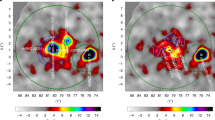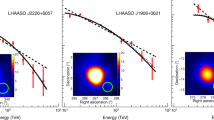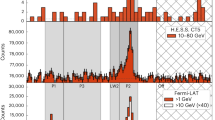Abstract
Samorski and Stamm1 have reported and Lloyd-Evans et al.2 have recently confirmed the detection of high-energy quanta, presumably γ rays, with energies E>2×1015 eV from Cygnus X-3. These ultra-high energy (UHE) γ rays were detected with extensive air shower arrays and included four events with E>1016 eV. Temporal analyses1,2 of the events indicate that the flux is modulated with a 4.8-h period and is sharply pulsed. Here (1) we discuss the implications of these γ-ray detections and suggest that autocorrelating the air shower data may be the best way to determine the intrinsic width of the γ-ray pulses; (2) we argue that the radiating particles are accelerated by a pulsar and that if they are accelerated according to any pulsar mechanism we know of, then they must be ions; (3) we note that if the ions are accelerated to 1016 eV by a large amplitude Deutsch wave, then the gravitational wave luminosity Lg should exceed that of the Crab pulsar by a factor of ∼5×105, and the spin-down time should be ∼80 yr (requiring a truly remarkable object); and (4) we show that the ions can be accelerated in the near zone but only if, contrary to the standard view, pair production does not greatly reduce the vacuum potential drop in the near zone. We note that near-zone acceleration could be confirmed by detection of curvature radiation.
This is a preview of subscription content, access via your institution
Access options
Subscribe to this journal
Receive 51 print issues and online access
$199.00 per year
only $3.90 per issue
Buy this article
- Purchase on Springer Link
- Instant access to full article PDF
Prices may be subject to local taxes which are calculated during checkout
Similar content being viewed by others
References
Samorski, M. & Stamm, W. Astrophys. J. Lett. 268, L17–L22 (1983).
Lloyd-Evans, J. et al. Nature 305, 784–787 (1983).
Nesphore, Yu. I. et al. Astrophys. Space Sci. 61, 349–355 (1979).
Danaher, S., Fegan, D., Porter, N. & Weekes, T. Nature 289, 568–569 (1981).
Lamb, R., Godfrey, C., Wheaton, W. & Turner, T. Nature 296, 543–544 (1982).
Lamb, R., Fichtel, C., Hartman, R., Kniffen, D. & Thomson, D. Astrophys. J. Lett. 212, L63–L66 (1977).
Parsignault, D., Grindlay, J., Gursky, H. & Tucker, W. Astrophys. J. 218, 232–242 (1977).
Becklin, E. et al. Nature 245, 302–304 (1973).
Bhat, C., Sparu, M. & Kaul, C. Nature 288, 146–149 (Corrigendum: 291, 168) (1980).
Fegan, D. J. & Danaher, S. Proc. 17th int. Cosmic Ray Conf. 1, 31–33 (1981).
Milgrom, M. & Pines, D. Astrophys. J. 220, 272–278 (1982).
Vestrand, W. T. & Eichler, D. Astrophys. J. 261, 251–258 (1982).
Gunn, J. E. & Ostriker, J. P. Phys. Rev. Lett. 22, 728–731 (1969).
Hertz, P., Joss, P. & Rappaport, S. Astrophys. J. 224, 614–624 (1978).
Vestrand, W. T. Astrophys. J. 271, 304–314 (1983).
Arons, J. in IAU Conf. No. 94, 175–204 (Reidel, Dordrecht, 1981).
Ruderman, M. A. & Sutherland, P. G. Astrophys. J. 196, 51–72 (1975).
Sturrock, P. A. Astrophys. J. 164, 529–556 (1971).
Boone, J. et al. preprint University of Utah (1983).
Dzikowski, T., Gawin, J., Grochalska, B., Wasilewski, A. & Wdowczych, J. Proc. 17th int. Cosmic Ray Conf. 1, 8–12 (1981).
Thomson, D. E. Sci. News 123, 405 (1983).
Author information
Authors and Affiliations
Rights and permissions
About this article
Cite this article
Eichler, D., Vestrand, W. Implications of 1016 eV γ rays from Cyg X-3. Nature 307, 613–614 (1984). https://doi.org/10.1038/307613a0
Received:
Accepted:
Issue Date:
DOI: https://doi.org/10.1038/307613a0
Comments
By submitting a comment you agree to abide by our Terms and Community Guidelines. If you find something abusive or that does not comply with our terms or guidelines please flag it as inappropriate.



